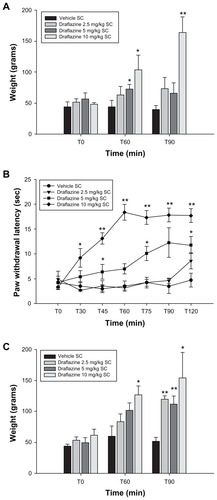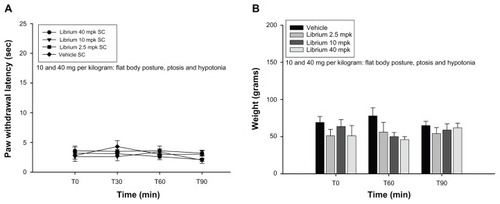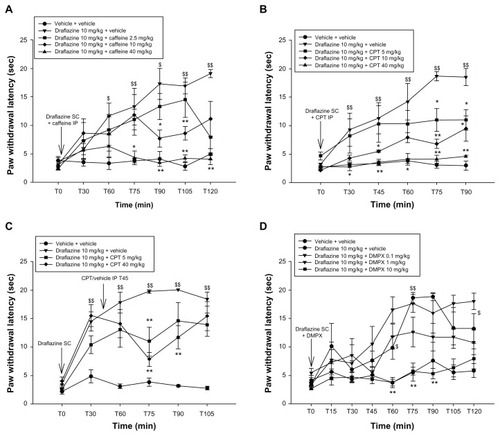Figures & data
Figure 1 Effect of various subcutaneously administered nucleoside transport inhibitors on complete Freund’s adjuvant-induced thermal hyperalgesia.

Figure 2 (A) Effect of draflazine in various doses (2.5–10 mg/kg) and vehicle on complete Freund’s adjuvant-induced mechanical hyperalgesia. Shown are the mean and standard error of the mean values for mechanical withdrawal threshold in grams for the inflamed left paw; 5–7 animals per dose group were tested. Dose groups were compared with the vehicle group using the Wilcoxon-Mann-Whitney test, with correction for repeated measures. *P < 0.05; **P < 0.01. (B) Effect of draflazine at various doses (2.5–10 mg/kg) and vehicle on carrageenan-induced thermal hyperalgesia. Shown are the mean and standard error of the mean values for thermal paw withdrawal latency in seconds for the inflamed left paw; 5–7 animals per dose group were tested. Dose groups were compared with the vehicle group using the Wilcoxon-Mann-Whitney test, with correction for repeated measures. *P < 0.05; **P < 0.01. (C) Effect of draflazine at various doses (2.5–10 mg/kg) and vehicle on carrageenan-induced mechanical hyperalgesia. Shown are the mean and standard error of the mean values for mechanical withdrawal threshold in grams for the inflamed left paw; 5–7 animals per dose group were tested. Dose groups were compared with the vehicle group using the Wilcoxon-Mann-Whitney test, with correction for repeated measures. *P < 0.05; **P < 0.01.

Figure 3 (A) Effect of chlordiazepoxide at various doses (2.5–40 mg/kg) and vehicle on complete Freund’s adjuvant-induced thermal hyperalgesia. Shown are the mean and standard error of the mean values for thermal withdrawal latency in seconds for the inflamed left paw; 5–7 animals per dose group were tested. Dose groups were compared with the vehicle group using the Wilcoxon-Mann-Whitney test, and no statistically significant differences were found. (B) Effect of chlordiazepoxide at various doses (2.5–40 mg/kg) and vehicle on complete Freund’s adjuvant-induced mechanical hyperalgesia. Shown are the mean and standard error of the mean values for the mechanical withdrawal threshold in grams for the inflamed left paw; 5–7 animals per dose group were tested. Dose groups were compared with the vehicle group using the Wilcoxon- Mann-Whitney test, and no statistically significant differences were found.

Figure 4 (A) Effect of caffeine at various doses (2.5–40 mg/kg) on the antihyperalgesic effect of draflazine (10 mg/kg) in the CFA-induced thermal hyperalgesia model. Caffeine was injected intraperitoneally immediately after subcutaneous injection of draflazine at time point T0. Shown are the mean and standard error of the mean values for thermal paw withdrawal latency in seconds for the inflamed left paws; 5–7 animals per dose group were tested. First, the draflazine + vehicle group was compared with the vehicle + vehicle group using the Wilcoxon-Mann-Whitney test. $P < 0.05; $$P < 0.01. Comparisons were then made between the draflazine + caffeine dose groups and the draflazine + vehicle group using the Wilcoxon-Mann-Whitney test, with correction for repeated measures. *P < 0.05; **P < 0.01. (B) Effect of adenosine A1 antagonist, CPT, at various doses (5–40 mg/kg) on the antihyperalgesic effect of draflazine (10 mg/kg) in the CFA-induced thermal hyperalgesia model. CPT was injected intraperitoneally immediately after subcutaneous injection of draflazine at time point T0. Shown are the mean and standard error of the mean values for thermal paw withdrawal latency in seconds for the inflamed left paws; 5–7 animals per dose group were tested. First, the draflazine + vehicle group was compared with the vehicle + vehicle group using the Wilcoxon-Mann-Whitney test. $P < 0.05; $$P < 0.01. Comparisons were then made between the draflazine + CPT dose groups and the draflazine + vehicle group using the Wilcoxon-Mann-Whitney test, with correction for repeated measures. *P < 0.05; **P < 0.01. (C) Effect of A1 adenosine antagonist, CPT, in various doses (5–40 mg/kg) on the antihyperalgesic effect of draflazine (10 mg/kg) in the CFA-induced thermal hyperalgesia model. CPT was injected intraperitoneally 45 minutes after subcutaneous injection of draflazine at T0. Shown are the mean and standard error of the mean values for thermal paw withdrawal latency in seconds for the inflamed left paws; 5–7 animals per dose group were tested. First, the draflazine + vehicle group was compared with the vehicle + vehicle group using the Wilcoxon-Mann-Whitney test. $P < 0.05; $$P < 0.01. Comparisons were then made between the draflazine + CPT dose group and the draflazine + vehicle group using the Wilcoxon-Mann-Whitney test, with correction for repeated measures.*P < 0.05; **P < 0.01. (D) Effect of A2 antagonist, DMPX, at various doses (0.1–10 mg/kg) on the antihyperalgesic effect of draflazine (10 mg/kg) in the CFA-induced thermal hyperalgesia model. CPT was injected intraperitoneally immediately after subcutaneous injection of draflazine at time point T0. Shown are the mean and standard error of the mean values for thermal paw withdrawal latencies in seconds for the inflamed left paws; 5–7 animals per dose group were tested. First, the draflazine + vehicle group was compared with the vehicle + vehicle group using the Wilcoxon-Mann-Whitney test. $P < 0.05; $$P < 0.01. Comparisons were then made between the draflazine + DMPX dose group and the draflazine + vehicle group using the Wilcoxon-Mann-Whitney test, with correction for repeated measures.*P < 0.05; **P < 0.01.
